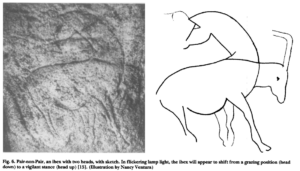Reading 2: “Cinematic Aspects of Cave Art” Reflection
Instructions
“Cinematic Aspects of Cave Art” (Due by 3/25): The author noted, “Giedion had suggested that prehistoric humans had a unique vision of time and space.” Reflecting the contents of this article, How are cave painting and cinema similar or different in the experience for time and space? Please answer this question(max. 500 words) on your blog.

Reading 2: “Cinematic Aspects of Cave Art” Reflection
In “Cinematic Aspects of Cave Art,” the author delves into the intriguing parallels between ancient cave painting and modern cinema, positing that cave art exhibits a cinematic quality in its depiction of time and motion. By scrutinizing elements such as light utilization, superimposition, and the irregular surfaces of caves, the author proposes that prehistoric humans possessed a unique perspective on time and space, shedding light on their worldview and cultural practices. Cave painting and cinema both offer dynamic and immersive experiences of time and space, each through distinct mediums and cultural contexts. Both mediums have the capacity to convey the passage of time and create a sense of movement, capturing the essence of temporality and motion inherent in human experience. Cave paintings, with their ancient origins and primal forms, use the natural irregularities of cave walls and the interplay of light and shadow to evoke a palpable sense of time passing, as if the images themselves are imbued with the breath of ages. As Giedion has emphasized, “the caves are not architecture. The walls may curve gently or abruptly in every possible direction. High vaults alternate with low, barely accessible passages. The spaces are never regular or predictable. Under a moving, flickering lamp, even the bare, irregular surfaces seem to come and go, to change and move,” highlighting how cave paintings, through their utilization of irregular cave surfaces and interplay of light and shadow, evoke a palpable sense of time passing, akin to the immersive experience of cinema. The components of these effects, as the author further elucidates, are “the irregular surfaces of the cave, a light source that moves and flickers, and a moving eye. The images were painted and etched under these circumstances so that they are visible from some viewpoints and not from others.” This quote elucidates how cave paintings were strategically crafted to be visible from certain viewpoints, akin to the deliberate construction of cinematic scenes, suggesting a shared intent to manipulate space and perspective for storytelling. Moreover, the article asserts, “In short, they made underground cinema,” underscoring the striking similarity between the immersive experience offered by cave art and the cinematic experience crafted by modern filmmakers. Similarly, cinema, with its modern technological prowess and narrative prowess, manipulates time and space through editing, cinematography, and sound design to transport audiences into a world where past, present, and future intersect. As Giedion had suggested, “prehistoric humans had a unique vision of time and space,” a perspective that resonates through the layers of history and culture embodied in both cave art and cinematic storytelling. However, despite their differences in technological capabilities and cultural contexts, both cave paintings and cinema offer profound insights into the human experience, inviting viewers to contemplate the mysteries of existence and the fluidity of time and space.
